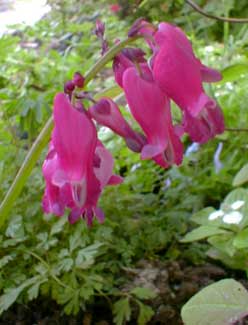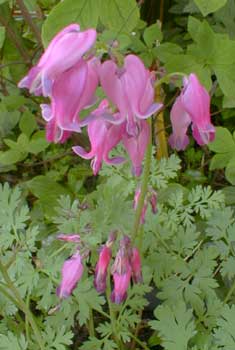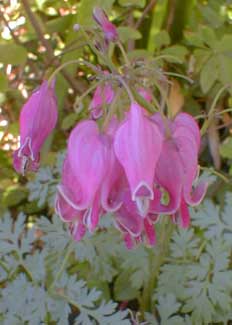
'King of Hearts'
Fearnleaf Bleedingheart
"What helps it now, that Byron bore,
With haughty scorn which mock'd the smart,
Through Europe to the Aetolian shore
The pageant of his bleeding heart?"
-Mathew Arnold
(1822-1888)
(1822-1888)
'King of Hearts' Bleedingheart was hybridized here in our own state, in Pullman, Washington, by Dr. Francis Marion Owneby (1910-1974), for whom the Marion Ownbey Herbarium at Washington State University is named. It was developed for market using tissue culture by White Flower Farm in 1992, & later liscensed to select growers, so that this variety took about a decade to become more-or-less widely available.
 It is a cross of the Japanese species Dicentra perigrina with two North American species, the Oregon Bleedingheart D. formosa ssp oregana, & the Eastern Bleedingheart, D. eximia. These latter species lend hardiness to the hard-to-grow Japanese species which 'King of Hearts' most resembles.
It is a cross of the Japanese species Dicentra perigrina with two North American species, the Oregon Bleedingheart D. formosa ssp oregana, & the Eastern Bleedingheart, D. eximia. These latter species lend hardiness to the hard-to-grow Japanese species which 'King of Hearts' most resembles.The ferny foliage of 'King of Hearts' is finer & more delicate of appearance than for either D. eximia or D. formosa, & of a much bluer blue-green coloration.
 As with other bleeding hearts it is not heat-tolerant & needs to be kept out of the sun. In the Northwest, so long as it does not dry out in summer & is not in direct sunlight, it will not go summer-dormant, although in droughty conditions or through a heat wave it may languish, then perk up fine as soon as the temperatures are back to normal & the soil moist. Ours did experience a heatwave its first summer in the garden, but in a shady moist location, so showed no sighns whatsoever of heat stress.
As with other bleeding hearts it is not heat-tolerant & needs to be kept out of the sun. In the Northwest, so long as it does not dry out in summer & is not in direct sunlight, it will not go summer-dormant, although in droughty conditions or through a heat wave it may languish, then perk up fine as soon as the temperatures are back to normal & the soil moist. Ours did experience a heatwave its first summer in the garden, but in a shady moist location, so showed no sighns whatsoever of heat stress.The foliage forms a spreading groundcover in the height range of eight inches to a foot. The flowers rise above the foliage on eighteen-inch to two feet, the hearts dangling along the upper stems. Blooms can occur as early as April & continue through the whole of summer so long as the clump does not experience a droughty period.
The flowers on our clump started out in April such a rich dark pink they come as close to a true red as any bleedingheart I've seen, almost a cherry-red. After a week, or if the sun hits them for a little while, they faded slightly, but still a very clear pure deep pink. The first photo snapped in April shows the flower a bit less red than at its reddest. Flowers later in the season weren't so red at any stage, but are silvery pink, as seen in the second photo, from the very end of May. The third photo shows a flower cluster at the tail-end of July.
It might not be so fantastically floriferous in deepest deep shade, but in too much sun it will not look its best in summer. Bright to moderate shade is its happy medium. If it does get tatty-looking during a hot spell, sheering & more careful watering schedule will snap it back to beauty. It wants moist rich humusy soil.
Ours grows between patches of 'Blue Panda' corydalis, & the contrast of luminescent blue fish-shaped flowers flanking rose-pink heart-shaped flowers makes this corner of the shade garden pretty exciting.